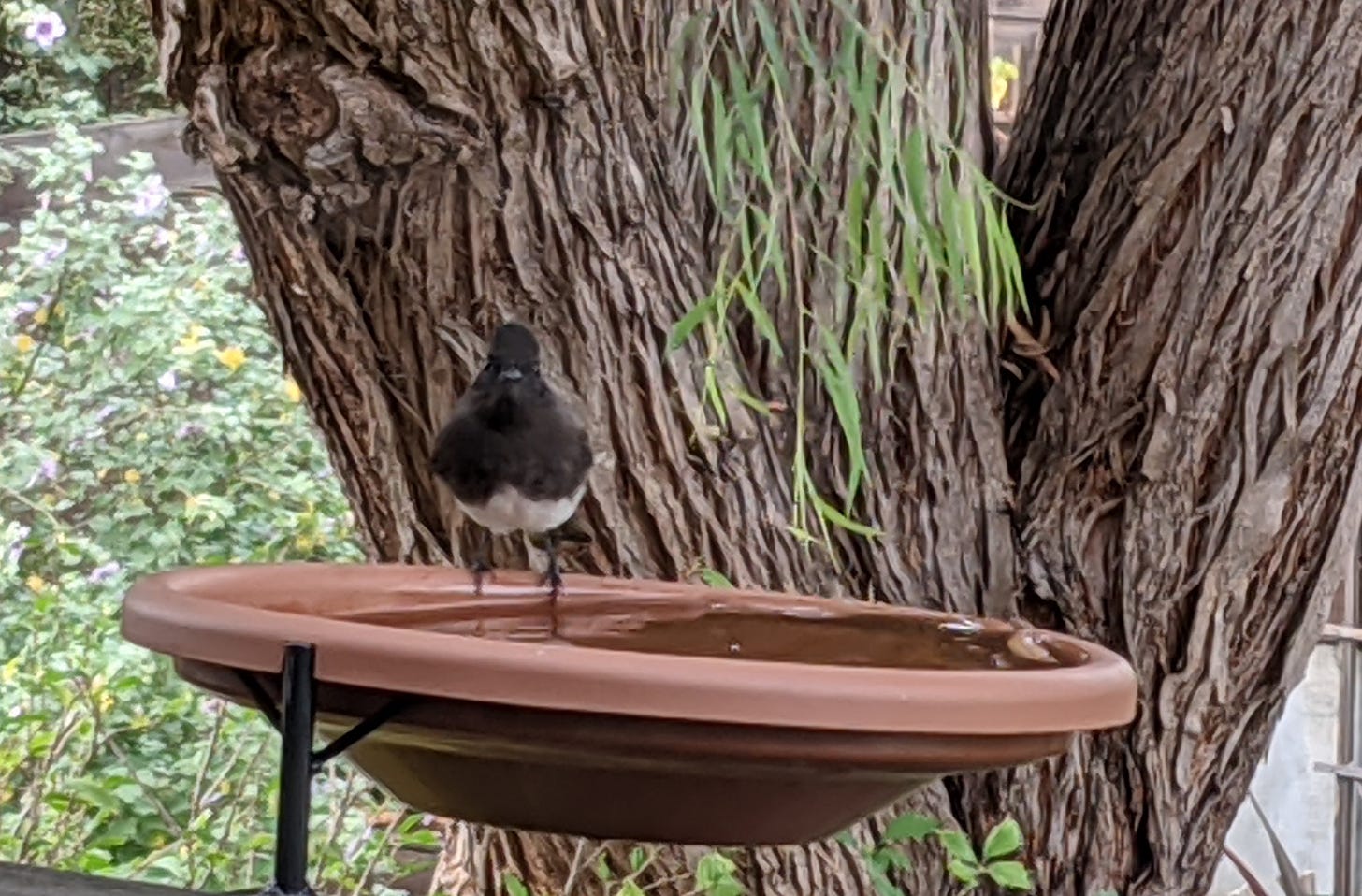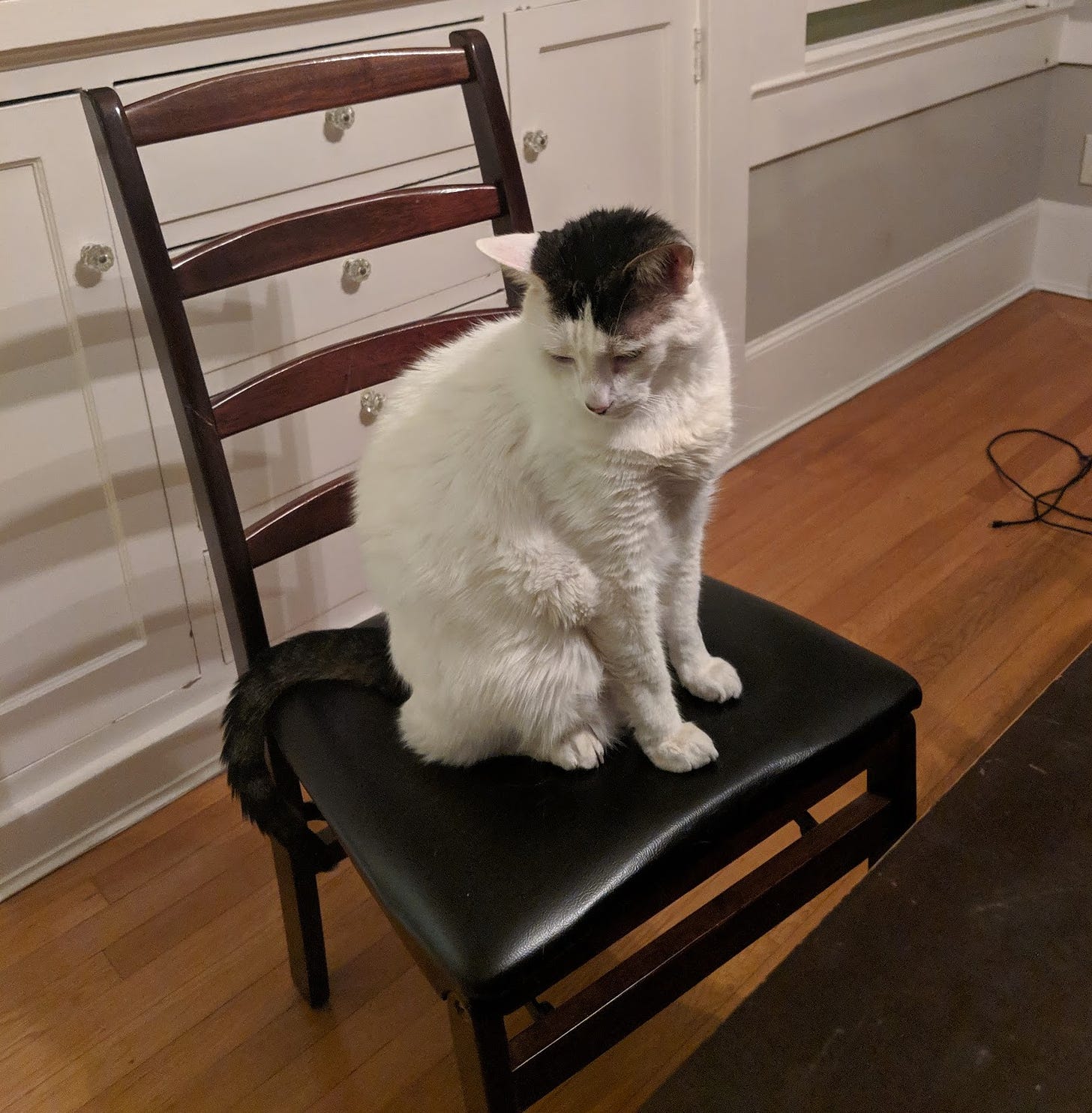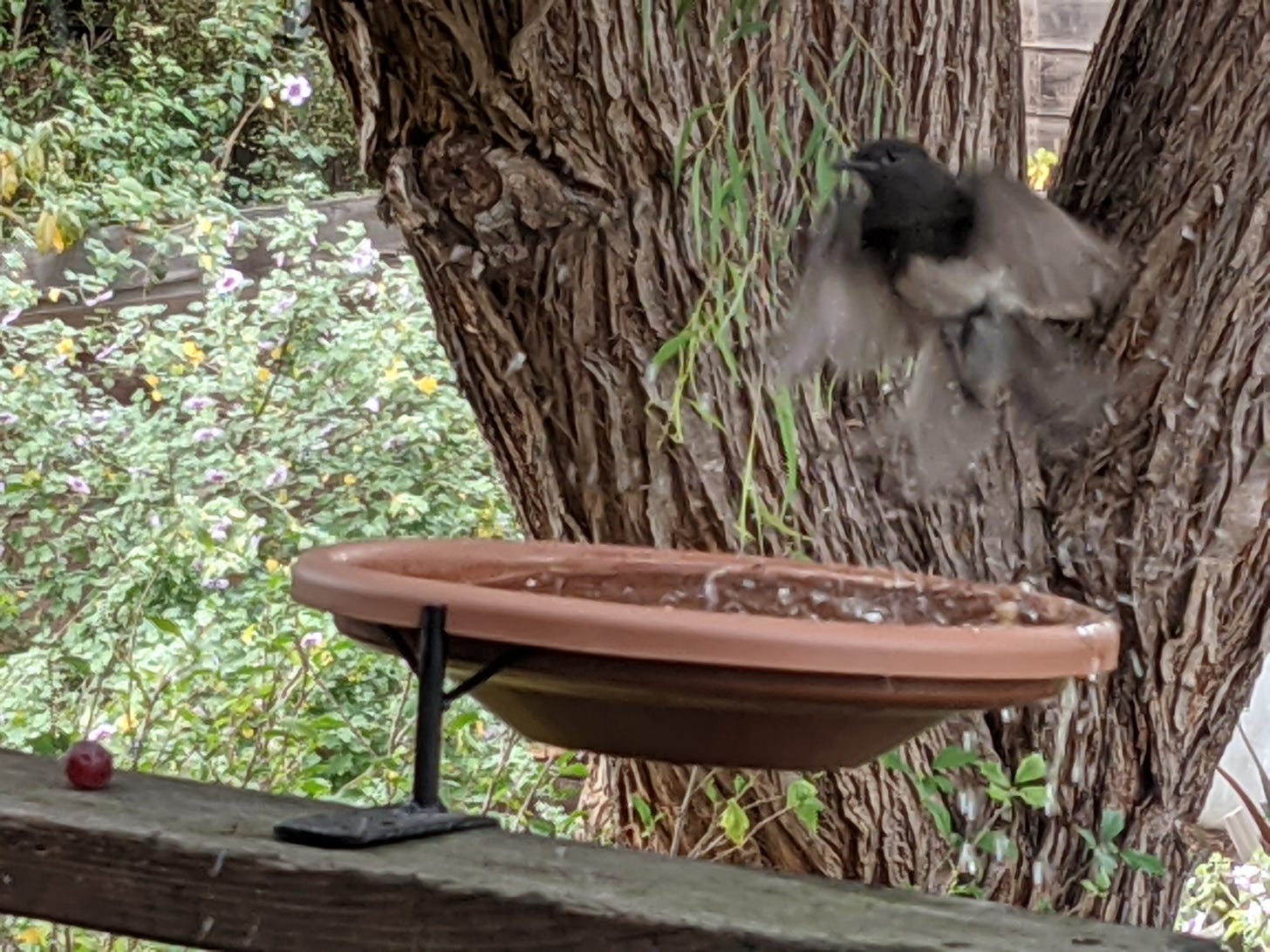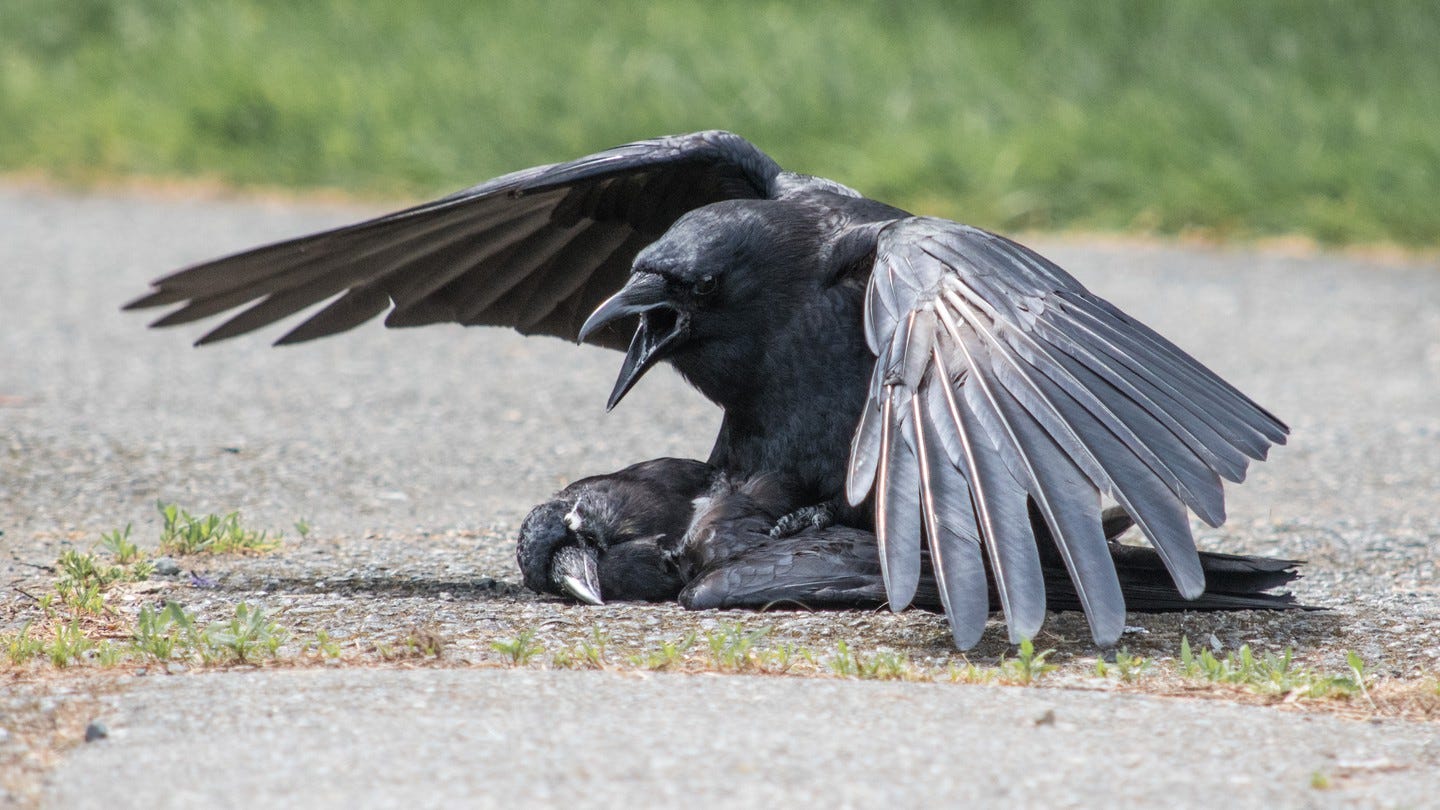She keeps taking baths on my balcony and singing
I continue to invent new ways to communicate with the birds who hang out in my backyard. This week, I attempt to discuss anthropomorphization with a black phoebe and two crows.
I have named the black phoebe Bath Queen because she was the first bird in the neighborhood to take advantage of the extremely small and precarious bird bath I have attached to the railing of my balcony. It’s a nice spot, right under the peppermint willow. There’s a lot of dappled sunlight and about a zillion flies zooming around, which is great for Bath Queen because black phoebes eat bugs. They also love water.

Black phoebes are small, about the size of house sparrows, and they have a black hood, black wings, and a very dapper white chest. They also have a small crest on their heads, which sticks up whenever they feel like it. Their call is basically what you expect from an archetypal bird — it’s a sweet chirp-chirp-tweet sound, and Bath Queen is not at all stingy with it. She sings when she alights next to the water; then she takes a tiny sip and sings; then she jumps all the way into the water and fluffles* her feathers before leaping out and singing even more loudly. Once in a while, she turns around on the ledge of the bath and swooshes her tail in the water. The more times she jumps in — usually about four — the more notes she adds to her song.
Here’s Bath Queen, above. You can hear an admiring human in the background saying, “Nice!” Because obviously, she is.
After bathing, she whirls to a nearby branch and shakes off for a while, carefully stretching and cleaning her wings with her beak. Sometimes a hummingbird follows her. Why does Bath Queen have a hummingbird stan? I suppose it’s possible that black phoebes lead them to food sources. If black phoebes are chasing bugs, and bugs chase flowers, then hummingbirds might want to get in on that action.
I’ll be honest. I don’t know. I also don’t know whether Bath Queen is actually a female monarch. Apparently it’s almost impossible to distinguish between males and females of the species — their coloration and songs are hard to tell apart. Same goes for rank. An aristocratic black phoebe looks exactly like a commoner. So I call her Bath Queen because I’m an anthropomorphizer who thinks that monarchy is for the birds.
*Yes, “fluffle” is a scientific term that combines the precision of “fluff” with the rigor of “ruffle.”
Anthropomorphization and you
Anthropomorphization is a fancy word for something we do every day, which is project human feelings and behaviors onto non-humans. When you have a conversation with your cat, and then do a special voice to make the cat say something like “Give me food!” or “Scritch me now!” — that’s anthropomorphization. It’s the bane of scientists who study non-human animals, because it’s so tempting to ascribe human emotions to our non-human pals. Anthropomorphization is why scientists use human ideas like “monogamy” to describe how voles mate. It also why the scientific term for mating among certain invertebrates is “traumatic insemination,” even though there’s no evidence that these animals are traumatized by piercing each other’s skin to deliver sperm.

I recently spoke to Kaeli Swift, a scientist who studies crows and other birds, about anthropomorphization. She did her doctoral work at University of Washington on crow “funerals,” or how these birds react to dead crows by gathering around them in groups and making loud cries. “Funeral” is, of course, a human idea — and Swift says she uses the term guardedly. Especially because sometimes these crow funerals involve a little necrophilia.
“I’ve gotten flak when I use ‘funeral’ to describe what they’re doing,” she said. Some people don’t like it because, as Swift puts it, “crows have this incredible following,” among mostly New Agey people who believe they have a spiritual connection with these animals. Swift added that these “crystals-in-the-window folks” say things like, “How dare you use funeral to describe gross things you’re finding?” But she also gets flak from other scientists, who think that the word “funeral” is too anthropomorphic.
Swift explained that she’s not trying to say the crows are sad, or in mourning, or any of the things that humans might experience. “If I call this a ‘cacophonous aggregation’ nobody is going to know what the fuck I mean,” she said with a laugh. “It’s just a way to communicate that they gather around their dead, and that is what they do. At its most basal level, that is what a funeral is.” She added, “That doesn’t imply that we know how they are feeling about the situation.”
So what’s the best way to talk about non-human animal behavior, if we want to be clear but avoid too much anthropomorphization? For Swift, the main thing is to admit when we don’t know why animals are doing something. “I don’t want to add narratives that are just guessing,” she explained. When we allow ourselves to be in a place of not knowing, we can observe animals more keenly and accurately, unburdened by preconceptions.
In the case of the necrophilic crow funerals, Swift said she speculates that the sex is a response to “conflicting impulses” or “stress.” But even those are just suppositions. The best way to understand this behavior is in the context of the crows’ other behavior. So, for example, we know that crows don’t always have sex for procreation. Sometimes female crows mount males. “That’s not a reproductive tactic. They’re not going to make a baby. There’s clearly some other behavioral or communicative consequence to that,” Swift mused. “We know they use sex in contexts where it’s not going to result in reproduction. Which means it’s serving some other sort of purpose.”
A necrophilic crow, in other words, probably isn’t confused and trying to make babies with a corpse. Crows sometimes have sex for purposes other than reproduction. But what those purposes are? Feel free to speculate. The best answer right now is that we don’t know.
Weird Feather and his friend
I have never witnessed a crow funeral, but I do spend a lot of time with the crows in my backyard, and have been observing them for roughly eight years. I’ve explored what scientists know about how crows use tools, and solve complex puzzles. And for the past two years, I’ve had a pretty regular crow visitor to the peppermint willow whom I’ve named Weird Feather. I recognize him by one unruly feather that sticks out of his right shoulder, and by the way he always alights on the same branch before landing — thwack! — on the railing next to the bird bath, where I leave him grapes and peanuts.
Weird Feather has always been a pretty solitary guy, but in the past couple of months he’s been bringing a friend with him. They land next to the bird bath and take turns drinking from it, as if they were waiting in line for the water fountain in elementary school. (See, there I am, anthropomorphizing.) Weird Feather used to ignore the bird bath, but now he’s pretty into it. He’ll land on the rim and drink — or dip his grape or peanut into the water a couple of times before eating it.
Above, you can see Weird Feather eating a grape I gave him. If you look carefully, you can see the feather sticking out of his right shoulder.
I can see his ablutions from my desk where I do video calls, and sometimes it gets distracting — Weird Feather and his friend are usually more interesting than a screen full of human faces in boxes.
Once you’ve watched crows for a while, you start to get used to their body language. My favorite is the way they loop one leg over top of a wing to scratch their heads. Weird Feather has a particular way he likes to eat, on a nice smooth branch with the food braced against the wood with his claw. Then he can peck open the peanut shell, or reduce the grape to smithereens before chomping. If I leave out two peanuts, he always does a little mouth Tetris, testing different ways to align them in his beak so he can fly off with both. I’ve never seen him give food directly to his friend, though he will sometimes yell until they arrive before sharing the grape feast (it sounds something like this).
Is his new friend a mate or just a friend? Do crows even make that distinction? Is Weird Feather male or female? I’ve guessed male only because he never makes the distinctive chopping call that females make. I’ve never heard his friend make the chopping call either, though. Mostly, they just yell, the way crows do, blasting their unknown messages out to the neighborhood. I can hear other crows replying distantly over the rooftops. Maybe, one day, we’ll know what they’re saying.
My next book is Four Lost Cities: A Secret History of the Urban Age. It's coming out in February 2021, and you can pre-order it now. You can find information and ordering links for my other books on my website, helpfully organized into science fiction and journalism. You can also follow me on Twitter or Instagram — or listen to Our Opinions Are Correct, the fortnightly podcast I co-host with Charlie Jane Anders. If someone forwarded this email to you, you can subscribe to it here.




